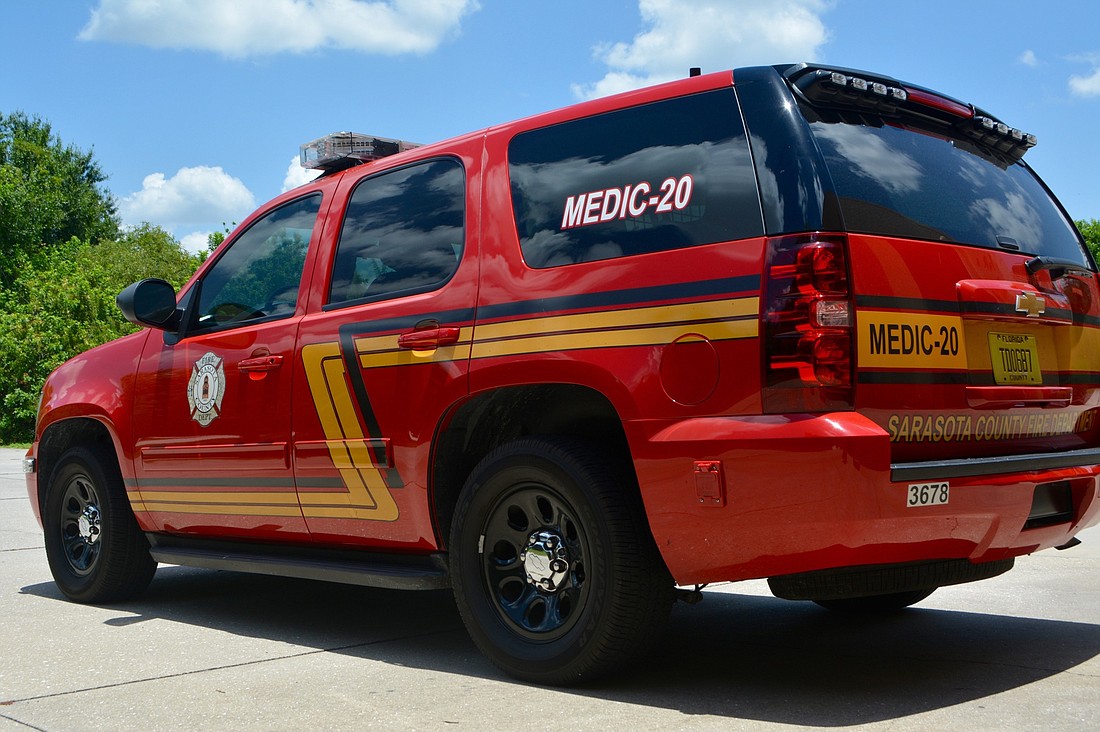- May 9, 2024
-
-
Loading

Loading

Along with Sarasota County’s growing population has come an increase in the number of calls for the county’s Emergency Services department. Between 2004 and 2018, fire-rescue teams have seen calls increase from 47,000 annually to more than 64,000.
While getting to all those calls and trying to maintain a benchmark response time of four to six minutes, Emergency Services Director Rich Collins said commanders have noticed something: The ratio of patients sick or injured enough to warrant a run to the hospital has remained relatively flat.
Specifically, hospital transports have risen in number along with the overall number of calls, but the percentage of transports in relation to call volume has remained flat or decreased slightly depending on the year. Normal transport percentage is 65%-70% of calls, according to Sarasota County Spokeswoman Brianne Grant.
So fire-rescue commanders decided to try something new in an effort to better match responses to patient needs.
In a 90-day trial based at downtown’s Station 1 and a follow-up trial launched in June in Venice, the department has deployed a Rapid Response EMS truck staffed by a pair of experienced medics. The idea is to carve through traffic quicker, arrive at a scene faster, assess a patient’s condition and, if necessary, begin treatment before summoning the nearest ambulance.
On a daily basis, the Sarasota County Fire Department has 29 ambulances running countywide. When Rapid Response EMS is on call for the day, that number is cut to 28.
“The premise of a Rapid Response vehicle is that the 911 system — fire and EMS — gets used for all kinds of things that aren’t necessarily always a necessity for a transport to the hospital,” Emergency Medical Services Chief Carson Sanders said.
Typically, he says, all 911 emergency calls will receive the same response involving a rescue or ambulance, if not an additional fire truck.
But the Rapid Response EMS vehicle being deployed will hopefully offer more suitable alternatives to patients in less critical need, which then cuts the county’s emergency services costs and helps residents receive appropriate care in a more timely manner.
The paramedics on board are highly experienced officer paramedics or field-training officers who are meant to elevate the level of on-site care.
The pilot program also uses a county-owned truck as opposed to a “transport vehicle,” such as an ambulance, to navigate neighborhoods and intersections more easily. Once the Rapid Response team has arrived, its job is to identify a patient’s needs. Should the patient need to go to the hospital, the team will call an ambulance.
If critical treatment is not necessary, they will instead explore what else might aid the patient.
Patients can save money, too. Per county ordinance, a patient is charged about $600 plus mileage when transported to the hospital. If the Rapid Response crew instead treats a patient on-site or deems an emergency transport unnecessary, that patient will not be charged.
“We’re looking to lead the way in emergency medical services for Sarasota County and the residents; they deserve that,” Sarasota Fire Chief Michael Regnier said. “So we’re looking to find ways to better serve the community and get the resource to the right place at the right time.”
Rapid Response is still in the testing phase, though, because officials have yet to see how necessary or helpful the system is in different areas of the county.
The first testing phase was completed in downtown Sarasota in May. During that 90-day period, SCFD responded to 711 calls by Rapid Response EMS. Fifty-four percent were transported by rescue to a hospital, and the rest were treated or advised by the responding unit.
According to both Regnier and Sanders, phase one reduced response times by about 34 seconds because of the vehicle’s ability to navigate city streets better than bulkier fire-rescue vehicles.
But the pilot program didn’t just cut response times; it also seemed to prove Sanders’ point about 911 calls. Averaging about 15 to 18 calls a day, it cut the number of times ambulances and fire engines were sent out on calls.
“Engine 1 was averaging somewhere in the neighborhood of 12 calls a day before we put the truck in,” Sanders said. “They averaged about three calls a shift after we put [Rapid Response] into service.”
As of June 12, the Rapid Response EMS team moved to Station 21 in Venice for another 90 days. The team will complete phase two data collection and compare results to downtown.
Afterward, Sanders and Regnier will consider whether they would like to pursue a third phase, though they are not yet sure what a third phase would entail.
But if the pilot program proves a continued success, Regnier says, they will approach the Board of County Commissioners next year to request funding for a more permanent model in the 2021 fiscal year.
“What is the best service for Sarasota County?” Regnier said. “That’s what we’re about. If we determine that this is a better way of using our resources, we will certainly share that with the board and get [its] approval to move forward with some kind of permanent project. But we don’t have that data right now.”